Turkey and Eastern Europe, April and May 2025
I've been back from India for about a month, and was not due in Canada for a couple of months or so. I had a few weeks available to try some more travel. I had been to Turkey only once, in 1976. I liked it then and had resolved to come back, but had somehow never got around to it, until now. I would travel to Turkey for about 2.5 weeks, look around alone for a few days, meet Maggie there, and tour Istanbul and surrounds together. As I had never yet been to Bulgaria, Romania and Slovakia, the two of us would then travel through these Eastern Europe countries for nearly two weeks. Finally we would meet our friends in Poland and spend about 2.5 weeks with them.
Turkiye (Turkey)
14 April had me on a flight from Sydney to Istanbul via Shenzen and Beijing. The flights were rather lengthy, encountering some hassles from having to "enter" China without a visa in Shenzen to get to Beijing and onward. However, I was in the newish Istanbul airport by early morning of 15 April. It took some time to do the long walks to get through the airport and Immigration - luckily I already had a visa - get a metro card with some cash on it, and find my way considerable distance again to the metro station. Then it was 2 metro lines and one tram line to the Sultanahmet district. A further walk had me in my hostel by about 09:00. My room wouldn't be ready until the afternoon, so I killed time by processing emails and other keyboard work, and resting in the common area. Being only mid-April, it was quite cool in Istanbul, mercifully not wet but definitely jacket weather.
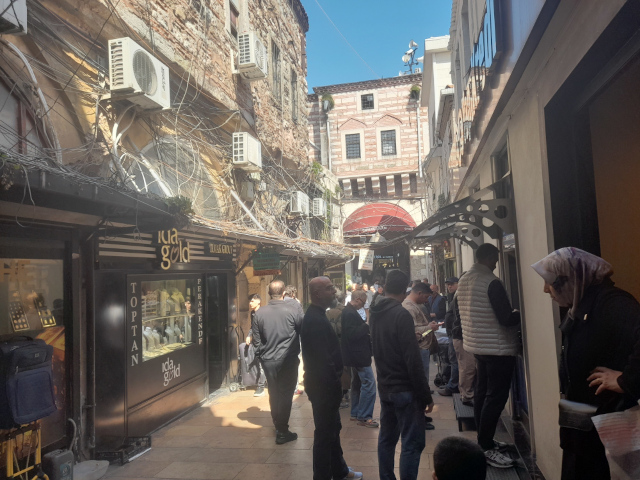
Grand Bazaar, Istanbul
Next day, my first full day, was also my first look-around. First thing, I had to make some ongoing accommodation and travel arrangements to put my mind at ease. Rooms seemed to be pretty full, so I had to search around for places to stay. Then find details of buses for later trips, both alone and with Maggie. Only then could I start to be a tourist.
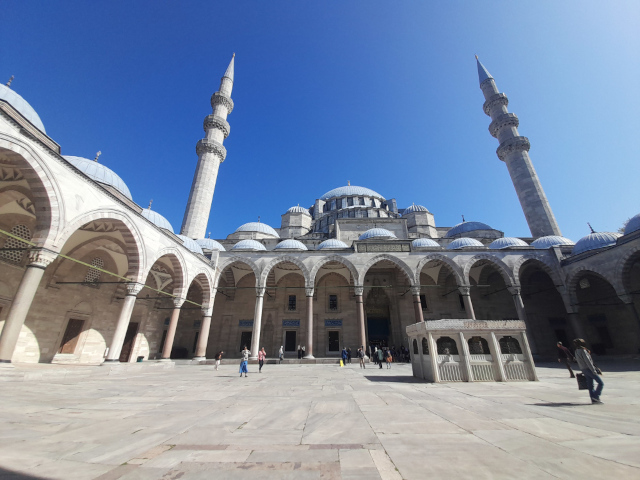
Suleimani Mosque, Istanbul
I was smack in the middle of the Sultanahmet district, with its mind-blowing concentration of mosques, cathedrals, palace and markets. I'd seen most of it half a century ago, and looked forward to doing it again with Maggie. I spend most of the rest of the day exploring around the Grand Bazaar and Suleymani Mosque. The bazaar is VAST, and I nowhere near saw all of it. It quickly became repetitive, one aisle looking much the same as another, and I couldn't tell where I'd been before. The Mosque was large and pleasantly attractive, I think prettier and more intimate than the more famous Sultanahmet Blue Mosque. I relaxed on the carpet a while, with many other people, soaking up the esoteric atmosphere.
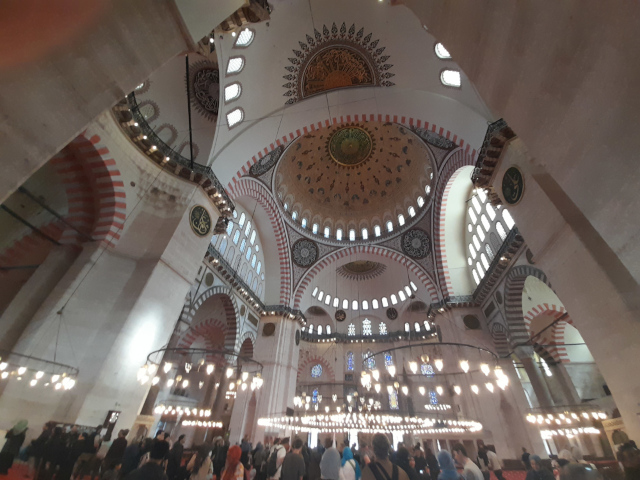
Suleimani Mosque interior, Istanbul
I was in Istanbul for only one full day before heading onward into Asia and to the Mediterranean city Antalya. The bus system in Turkey is comprehensive and efficient. A night bus would leave the Instanbul Eselner Otagar (bus terminal) at 5pm to arrive Antalya at 6am next day. I managed to find and take the Metro into the downtown and walk the short distance to my hostel.
I would be in the ancient Roman city Antalya for two part days and two full days, before I had to get back to Istanbul and meet Maggie. Being on the Mediterranean, and somewhat historic, Antalya is a tourist destination and it shows. It appears to be predominately a tourist hub, with an infinite number of restaurants, bars, travel/activity offices and other tourist infrastructure.
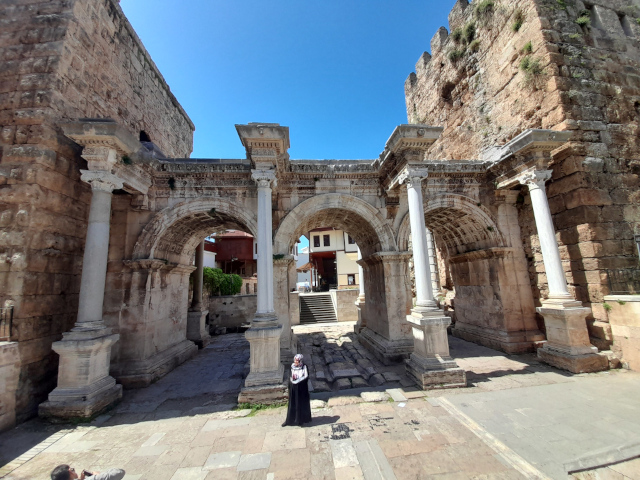
Hadrian's Gate, Alanya
While waiting for my bed to become available, I took a walk to the Old Town to explore. I entered from Hadrian's Gate, a three-arched stone entrance with supporting columns. It's pretty much the most impressive feature of the Old Town. There are stone walls, minars, mosques and other ancient features, but not much is really spectacular. I walked down a main street from the gate toward the waterfront, past many of the above businesses. It was still charming though, with its narrow winding stone streets and ambient atmosphere. To the east along/above the shore was the large Karaalioglu Park, a relaxing place with a large number of interesting sculptures.
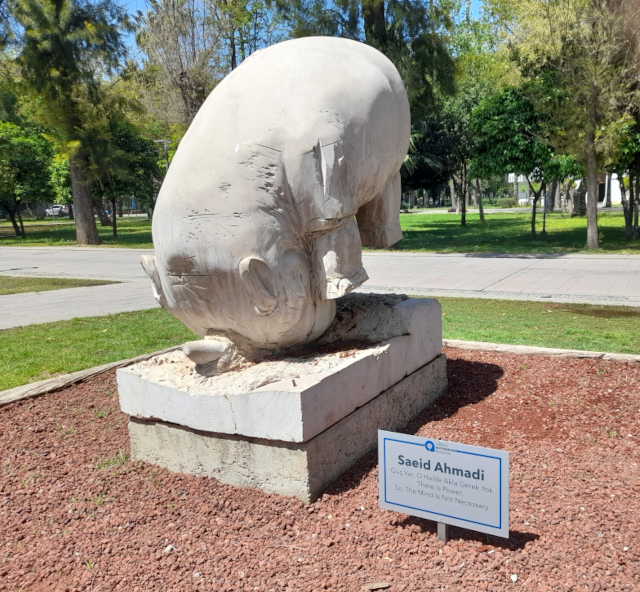
Sculpture, Karaalioglu Park
Next day Today I went again to explore more of the old town, this time more toward the right and around the edge. I found more minaret towers, Islamic arches, walls and other structures, Good views from the heights over the rest of the town, the marina and to the east. Too steep for steps, you must take an elevator down to the marina level, from where you can walk around the marina to a small lighthouse. There is a small beach, the only one in town, but it's closed for renovation; the other beaches are all out of town.
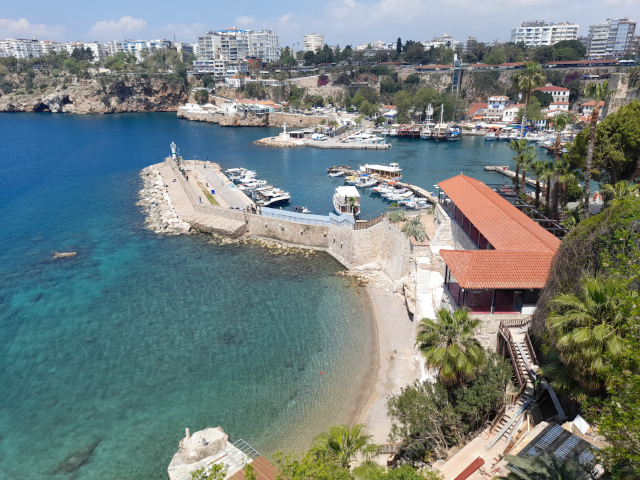
Marina, Antalya
The weather, and general pace, are more amiable than Istanbul, and the rest of my time in Antalya was well wasted in relaxing and chilling out. On the evening of 21 April I was on my way on another Flixbus back to Istanbul.
Back in the Eselner otagar around 07:00 in the morning, I boarded a very crowded metro back to the Askaray station, on the tram back to Sultanahmet, and to the hostel where I'd previously stayed. I had breakfast and spent most of the day checking in, resting, cleaning up, catching up on emails and notes, calling Maggie in Amstardam at the time (we both had sim cards and WhatsApp), and preparing for her later arrival on Turkey.
Retracing the tram and metro route back to the Istanbul airport that I had used several days ago, I was there at 18:00 with a couple of hours to spare before her arrval. Her plane was on time and it was great to meet up after a long journey for both of us. The metro and tram had us in Sultanahmet and our accommodation at 22:00.
Next day, 23 April, was the first day for us together in Istanbul. It was cool out today, but we went out and did a walking self-tour of parts of the Sultanahmet district in the morning and early afternoon.
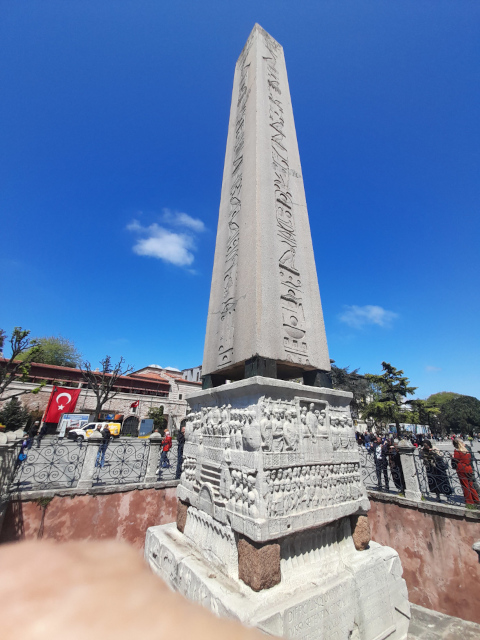
Roman Obelisk, Sultanahmet
Starting with Sultanahmet Park, we looked at Hagia Sophia, the Haseki Baths, Blue Mosque, Hippodrome (former racetrack), Egyptian Obelisk, Serpent column, Obelisk of Theodosius, and the German Fountain. These sites are all in a small area, so not a lot of walking to get to each. The mosque is called "Blue" for its interior tiles colour, but the blue seems decidedly faded, and not really a defining colour for the mosque.
While we were around the obelisks, we felt the ground shaking a bit, assuming it was a passing train or something, but it turned out to have been a 6.5-mag earthquake. Surprisingly it was all over the news later, quite a serious event, with about 150 injuries - mainly from people panicking and jumping out of buildings. Around mid-afternoon we walked over to the Grand Bazaar for a bit of a look; Maggie wasn't rapt in it, too big and crowded for her taste. Beyond the market, we continued past the University to see for my second (third?) time the magnificent Suleymani Mosque. There we sat on the carpet and took in the spectacle and ambience of the interior. Returning to the main tramway street, we found a slightly upmarket restaurant that had a selection of meals on trays, with a good-looking chicken-vegetable-rice dish. Then back home early evening for a brief rest, and later up to the bar to do computer things and pleasant drinks of beer and vodka sunrise.
Next day, again a cool day, we would go in the afternoon up to the "New City", across the Golden Horn river, and do the walk along the length of Iskital Kaddesi, the modern trendy street full of shops, restaurants, bars and vibe life.
The excursion comprised a walk to Sultamahmet stn, a tram to Universite Station, walk to Vezenciler station, metro to Taksim, and on to Kaddesi. Taksim is a large plaza with a historic water depot, a newish (century or so) mosque, an Ataturk Republic monument, a terminus of a small historic tram, and the start of the Iskital walk (along the tram line). After an initial orientation we set out walking along the street. It was an interesting walk, crowded even in the cool, an infinite number of shops, restaurants and other tourist/local businesses and loads of ambience. We could look up many of the more historically significant shops in the guidebook as we walked along. It took maybe a couple of hours to do the mile or so to the Beyoglu/Tunel end. We stopped at a coffee shop for a couple of coffees and cheesecakes, very pleasant, though we had to sit inside because of weather.
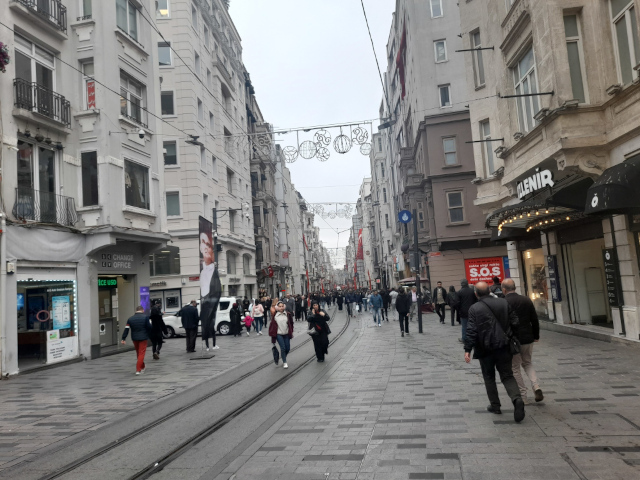
Iskital Kaddesi, Istanbul New City
At the end, we intended to take the funicular tunnel to the lower Karakoy end, and then the tram back to Sultanahmet. But we had great difficulty finding the funicular, until someone told us it was closed. So we had to get on the metro at Sishane station, and go back to Vezenciler. There about 17:00, we walked back along the street, where about 17:30, we found a restaurant for dinner of an adani (kebab) plate and a Turkish pizza.
We had not planned to spend our entire Turkish time together in Istanbul, having made arrangements to spend a couple of days in Selcuk, about 8 hours away in west-central Turkey, to see the Ephesus Roman ruins and related historical sites.
On the morning of 25 April, we made our way to the otagar, and started to ask around about buses to Selcuk. Everybody looked slightly shifty. But we did get two bus tickets for Selcuk. We waited around, the bus was late, and we didn't leave until 12:35 or so.
It took hours to clear the vicinity of Istanbul, making me wonder when we would ever get there. Only well into the journey did we speed up appreciably. But I had a bad gut feeling about this trip and continually wondered if they would dump us and abandon us in Izmir or somewhere at night. We did eventually get into Izmir around 20:00 or so, just on dark. And yes, they did dump us off the bus. But, they then did direct us to a mini-bus, no extra charge, which left fairly soon for a quick run in the dark to Selcuk, and dropped us at a roundabout near the otogar. With my map, were able to navigate to the Ephesus Centrum Hotel around 22:00. So we made it OK, after all the worry. It was a nice room and we settled in immediately.
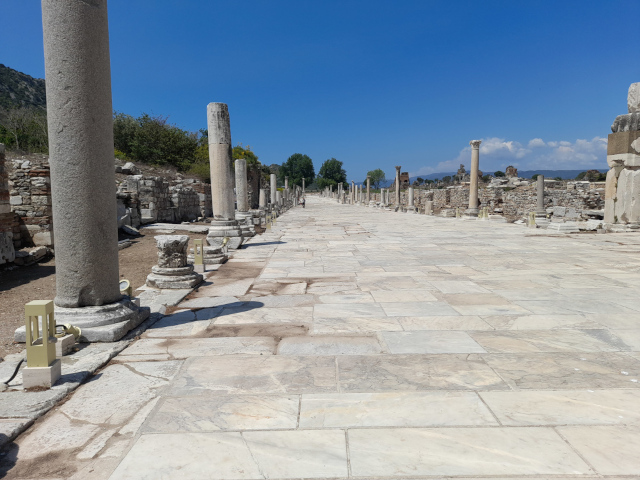
Roman Street, Ephesus
We have two full days in Selcuk before we have to head back to Istanbul. We took in the "major" activity on the first day, i.e. visit the Ephesus ruins. after breakfast, we saw that all surrounding streets around the hotel were now set up for a Saturday market, very crowded and lively.
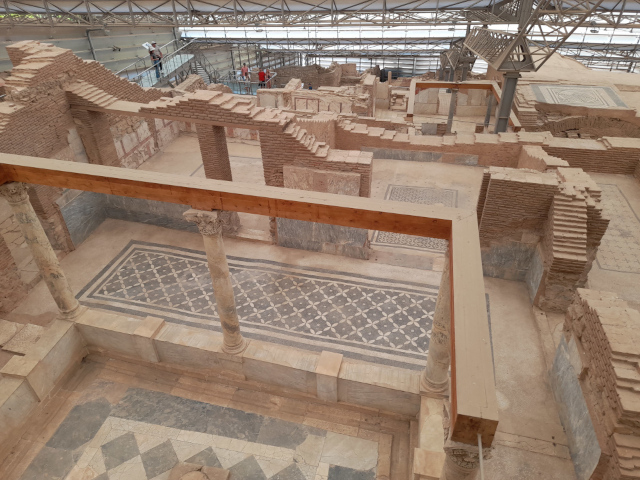
Terrace Houses, Ephesus
We went to the otogar and found a minibus (TL40 each) to take us the few km to the lower entrance of the Ephesus site. Ephesus was a major Roman city in its day, almost rivalling Rome at the time. The entrance fee included a "museum" audio-visual show (a bit weird, British/Disneyesque, but not bad) and a visit to the terrace houses (worthwhile). We took it slow, maybe about 5 hours to see everything from bottom to top, and it was worth it. We took in inter alia the Virgin Mary Church, Commercial Agora, the Terrace Houses, Latrines, Amphitheatre, Library, Odeion theatre and various other monuments and gates. Had a great time but were tired by the end. Still we walked the 3-4 km along the roads back to town and home.
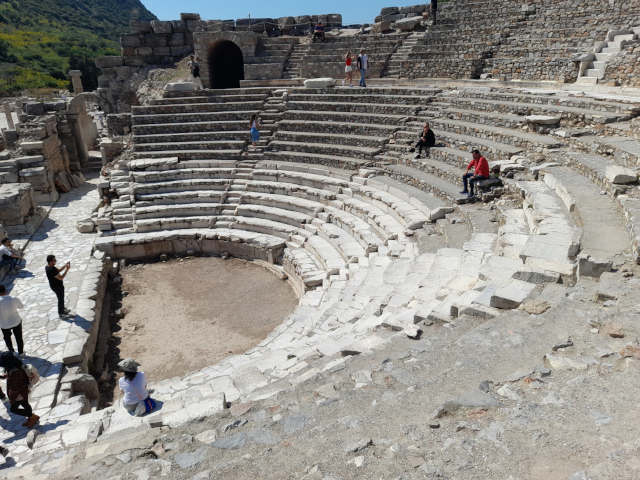
Odeion Amphitheatre, Ephesus
There are stray cats everywhere in Turkey, in the ruins and elsewhere. People like them, feed them, make shelters for them etc. They apparently keep the rats down. We saw a sizeable cat colony near the Ephesus entrance.
Our second full day in Selcuk was slow-paced relaxation and seeing some of the nearby sites. In the late morning we set out walking at a slow gentle pace, as Maggie's bakers cyst seemed to be playing up. We went the short distance to the Ayaslug Hill area, where a number of prominent sites were located. On the lower part of the hill was the large ruin complex Basilica of Saint John, where John spent some time, wrote his gospel, and was entombed. The basilica ruins were quite extensive, covering a large area, including a treasury, baptisary and site of John's tomb. Good views looked over the Isa Bey Camii mosque, which I didn't go to as you could see it all from the Basilica, to the single pillar of the slightly more distant Artemis Temple, and the surrounding town and valley. We continued up through the upper part of the Basilica, and on to the walled citadel at the top of the hill. Maggie waited near the citadel entrance while I went inside the walls and up the remaining distance to the summit. There was not a lot in the citadel except a lot of stone and a couple of empty buildings, and more views of surroundings. Access was mostly roped off, and not many places you could walk.
Next day, 28 April, we were on our way back to Istanbul. A minibus took us an hour or so to Izmir, and a bus at 11:00 had us in the Istanbul otogar at 20:30, about 2.5 hours late. There seems to be an unwritten rule that, for whatever obscure reason, they vastly lowball the arrival times. "Day buses late, night buses on time."
The hostel we'd been in was now full, so we had been forced to find alternative accommodation. Not much was available, and we had to move for 4 nights to the questionable Koba Hotel in the Kumkapi district a couple of km away. It was a km or so walk from the Yenkapi metro, but we made it OK by about 21:30. There were no chairs, internet was wonky, and gew racks to hang things, but we could survive.
The following day, we slowly walked back streets through the Kumkapi district (quite lively and pleasant with many shops and restaurants) and up to the Sultanahmet district. Maggie wanted to see the Aya Sofia (chequered history as cathedral, mosque, museum and now again mosque), which I didn't bother with myself because I'd been there before in the 1970's. She got into line and got in, while I loitered and read near the park fountain. Weather was cool and sunny, with a stiff wind, so it wasn't all that comfortable out there. Maggie came out of the Sofia after less than an hour inside; it was OK for her I guess.
When I'd been in Istanbul in 1977, I was only there about 3 days. I'd wanted to see the Topkapi Palace at the time, but it was closed on the desired day. So now I get another chance. It took maybe 3/4 hour to get to the entrance to Topkapi. There was something of a line to get tickets, but we could jump a queue by paying cash.
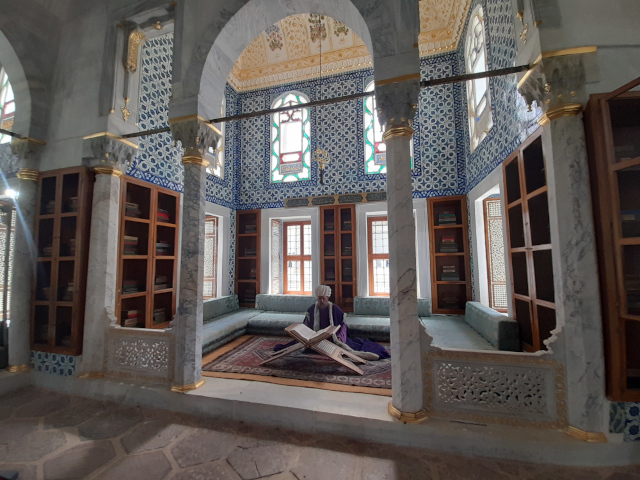
Library, Topkapi Palace
We got into the palace complex by about 11:00 and were there until 16:00, about 5 hours. Well, there is a lot to see, and we want to get our money's worth. It was moderately interesting and worthwhile. There were a lot of museum-type exhibits, which I enjoyed but far too many to devote enough time to each. Maggie was not totally impressed, having been looking forward to a plethora of architectural spectacles and beautiful buildings, but instead ultimately overdosing on museum exhibits. Her knee was playing up a bit so she ended up sitting out a lot of the areas and rooms/chambers that I went in to see. I (we) took in inter alia the extensive kitchen complex, the Divan rooms, armory exhibits, calligraphy, treasury, and of course the extensive Harem (which I thought wasn't greatly better than the rest of the complex). Note that the "harem" has a reputation for concubines and debauchery, but it is actually a term referring simply to the family living quarters.
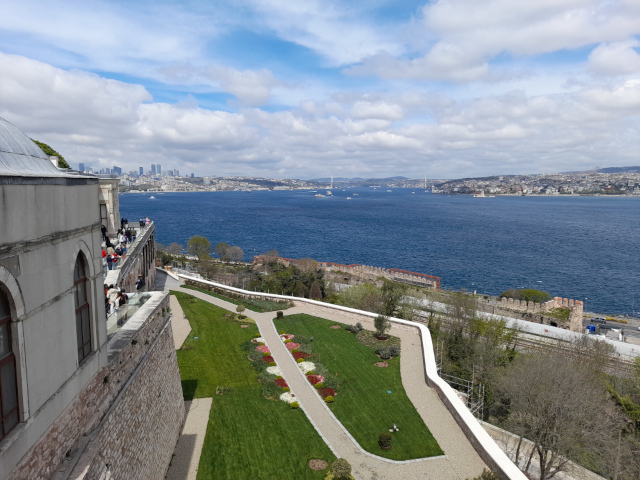
The Bosphorous, from Topkapi Palace
Our third and final day in Istanbul was a "day off", chilling out, short walks in the rain, doing emails and notes, and preparing to move on to Bulgaria tomorrow.
And that was Turkey. It wasn't as attractive and "returnable" as I had imagined in the 70's, but I wasn't expecting that; things have of course changed. It was however still a good destination and well worthwhile.
Bulgaria
On 2 May, we leave Turkey and off to Sofia, Bulgaria. The Flixbus is to leave from the otogar at 11:00, so we checked out about 09:00, walked to Yenikapi station, onto the metro, and to the otogar in good time.
We left not long after 11am, and had a good run to the border. Then things went pear shaped, as it took forever, like hours, to get through the border, partly because the bus had defects leading to delays and a fine. Finally getting going, we passed through pleasant Bulgarian countryside with a few stops, and eventually into Sofia Serdika nearing 22:00, about 2.5 hours late. Rules apply; day buses always late. We were however able to navigate our way to the Like Home GH, communicate with the owner, and find out how to get in. All OK. Not a bad place, comfortable.
On the way we had met an Asian student girl Tracy from Chicago, talked to her a lot, and agreed to maybe meet up tomorrow to tour together.
In the morning we were ready to go out for 09:00 and meet Tracy around the Alexander Nevsky Cathedral, one of Sofia's main landmarks. Maggie and I walked the approx 1/2 hour to the Cathedral eventually met up with Tracy around 09:30.
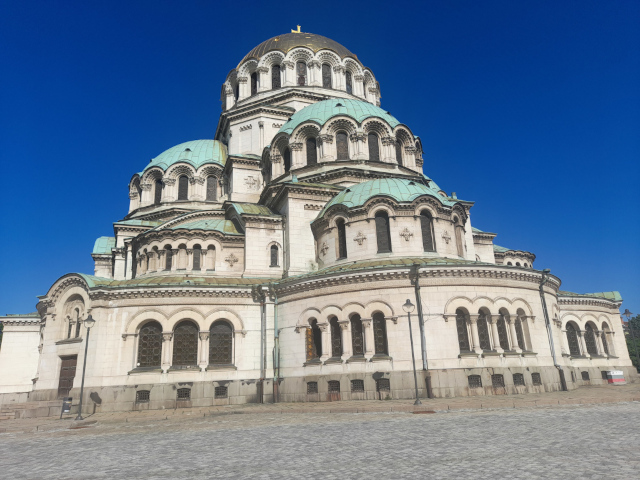
Alexander Nevsky Cathedral, Sofia
First thing was to do a bit of a walk around and in the Cathedral. The back with its multi layers of domes is more impressive than the more plebeian front, and the interior is the usual impressiveness for this class of edifice. Nearby the Cathedral is the St Sophia Church, I think the inspiration for the name of the city. Inside and below is an interesting vaulted crypt, and outside is a Tomb of the Unknown Soldier.
Also nearby is a statue/monument of a 11th century Tzar Samuil, with the most steely penetrating eyes I had ever seen on a sculpture. I believe the eyes were in response to a defeat of his army by the Byzantines, in which the victors deliberately blinded 45000 of his captured Bulgarian soldiers.
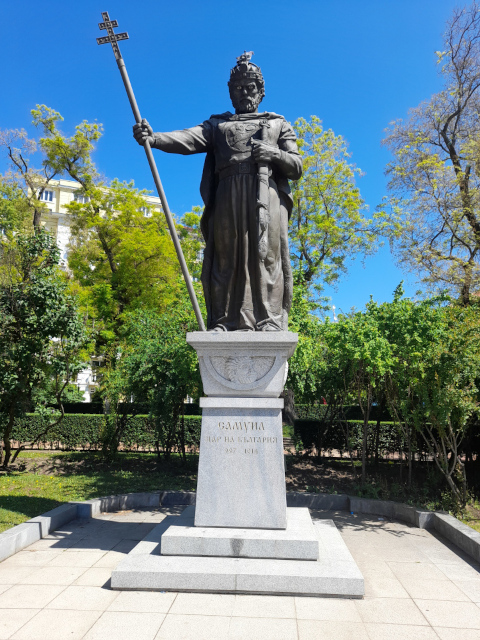
Tzar Samuil, Sofia. Just look at those eyes!
Slightly onward is the smallish but beautiful Church of St. Nicholas the Wonderworker, with its colourful tiles and domes and gold trim.
Then on to the City Garden, with its large and beautiful fountain in front of the equally beautiful and columned Ivan Vasov National Theatre.
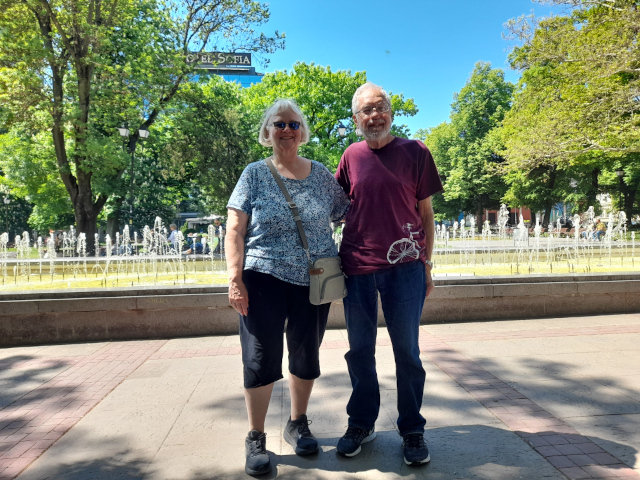
Maggie and Me, City Garden Fountain, Sofia
It was a longish walk from there to I think the large Borusova Park. The park boasted many lakes and monuments, even some forest, as well as people/families everywhere out and about enjoying the Saturday in the parks. We passed the small lily-covered Tulip Lake, up a small hill to the imposing Bratska (brotherhood?) Monument, I think a brutal-looking memorial to the liberation from communism. Onward to a coffee shop called Lazy Park, full of families, where we had coffees and icecream. Then back via paths, various structures and lakes to Orlov Most (Eagle Bridge) with it 4 eagle sculptures, and into the metro station and home.
We had a subsequent day of rest, relaxation and little activity, followed by another day in which we would be leaving by bus late in the evening for Bucharest, Romania. Because there's early check-out, a late train, and a late check-in next day in Bucharest, it's to be a long stretch of travel and homelessness.
We packed up, did final computer things, and stayed in the room in our Sofia GH as long as we could, checking out at 10:00. So, what do we do from now until the bus time at 11.30 pm?
First was to go to the train station, where there is a luggage store room, in which we could leave our gear there until 21:00. In the south of the city is a large park called (drum roll...) South Park. As the metro line goes straight there, and we can easily board by tapping credit cards, we decided to go down to the park and spend as much time as we could wandering around, sitting and exploring. A metro station was near the mid-point of the park, and we discovered a large shopping mall next to the park. We spent some time looking around the mall, then walked through the park, exploring pathways, lakes, nature and sculptures, and the symbolic iron sculpture of the Tit bird symbol of Sofia.
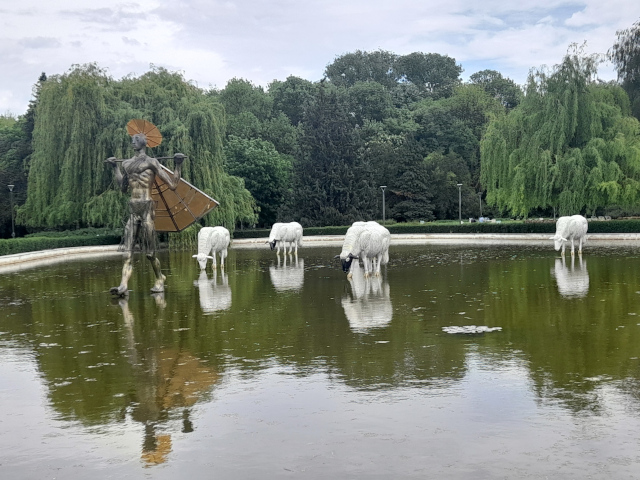
Sculpture in Pond, South Park, Sofia
After several hours in the park, we came back to the mall for coffees and cake, then walked through the north of the park, past Republic Square and an arts district, and to another metro station from which we came back to the train station sometime late afternoon. We hung around the train station a while until we picked up our gear at 20:30, had a bite to eat, and over to the bus station waiting room to wait for our bus.
All in all, it wasn't all that traumatic having to be homeless for the day, but it's not over yet. Our bus left pretty much on time at 23:30. Unlike day buses, the night bus zipped through the night to our destination in Bucharest Militari bus station with no delays. It was interesting that Flixbus advertise toilets on buses, but they are either removed or locked, and you can't use them, I think because the bus drivers are too lazy to look after them. One or two guys asked to use the toilet and were refused. They later had to beg the driver to stop for them to have a leak.
So that was Bulgaria, mildly attractive but not all that compact nor easy to walk around, a moderate number of attractive/historical sites, and and sometimes hard to find a good place to eat.
Romania
06:00 on 6 May had us on time (well, it's a night bus) in the Bucharest Militari bus terminal in the west of the city. As our booked Victoriei GH doesn't allow check-in before 15:00, we were wondering what to do with ourselves all morning. There's nothing open in the bus station, we had no ROM currency, and it was far too early, and maybe uncertain, to try to take the Metro downtown. We had noticed that there was a McDonalds on the street a couple of km back (west), and we decided to slowly walk there with all our gear and kill time there. I found a bank machine and could withhdraw some ROM cash.
After an interminably long walk along the street, we found the Maccas, and had a couple of breakfast mcmuffins and hashbrowns, payable by credit card, no cash. We were able to waste a couple of hours there.
Maggie noticed on a map that there was a large shopping mall a km or so north, so we lugged our gear up there to kill more time. We got a coffee there (credit card again), had a look around the mall in shifts, and managed to wile away a few more hours in a food court. The mall itself is pretty much like any other anywhere in the world, with the usual H&M's etc. From the long homeless day yesterday, the night bus ride with little/no sleep, and a homeless day today, we were getting tired, and tried to put heads down on the table.
By about 13:00, we decided to slowly make our way back to the Pacii metro station, near the Militari bus station. With our cash, we were able to enter the Metro and get two single tickets to Izvor Metro station for ROM180 each. The metro ride was quite normal and good, and let us off downtown around 14:30. It was a walk from there to our Victoriai 56 accom, almost exactly at 15:00.
No-one was there to receive us, and we didn't know where to go and how to get in to our room. We tried calling the owners, but Maggie's phone didn't work for that number. We had to get help from the people downstairs to call the owner. He was quite upset with us, apparently trying for some time to call us and leave instructions and for us to contact them, all after we'd left home and had no internet access, and he was scolding us for getting neighbours involved. Eventually we were able to configure WhatsApp to contact them, and get the instructions to get in, and later to get internet access. A most unpleasant interaction! The whole place was run-down and slightly grubby, but otherwise not bad.
We'd be in Bucharest for 3 full days before heading on to Bratislava, Slovakia. By now Maggie had become roundly sick of buses, with their unreliable timetables and toilet difficulties. We resolved to try the train system for the rest of the trip.
On the first full morning, we walked the 2 km or so to to the Gara de Nord railway station to try to exorcise the last of our stressy uncertainties: how to get from Bucharest to Bratislava. We got there around mid-late-morning, found a particularly fluent and helpful ticket woman, Elena, and were able to negotiate what must be under the circumstances a perfect itinerary. We would come back to Bucharest Nord at 15:07 on 10 May, 2-tier sleeper, arrive Budapest Keleti 05:00 on 11 May, make our way ~2km to Budapest Nyugati, board the 07:30 to Bratislava Hlavna, and arrive at 09:55 on 11 May. That means we have time to change stations in Budapest, and arrive in Bratialsva only a couple of hundred metres from our accom.
Elated from our train arrangements, we slowly walked back to Calela Victoriei to take in some of the sites there. On the way we passed and entered the cute little St Joseph's Cathedral. Then on Victoriei, we took in the Romanesque Gradina Ateneuili concert hall, with many well-dressed students outside having a grad ceremony and photos. Then the "Royal Palace" which is now mainly an art museum. On to a Carol I statue and library, and the even cuter Orthodox Cretulescu. Through a small "Dubcek" Park, and into the large Cismigiu Park, with a couple of lakes/ponds. We walked the length and breadth of this park, but Maggie was not really impressed with its unkempt, unmown appearance. We would find that most parks in Eastern Europe are not mowed, tall grass and weeds making for poor conditions for picnics and laying on grass. Dinner that day was a plebian but good Pizza Hut pizza, and later a treat of drinks in a bar near home, most pleasant.
On the second day, Maggie had booked a tour of the massive Parliament Palace for 12:30/13:00. It was a half-hour or so walk to the place where the tour starts. The palace was built by Caeucescu in the 1980's and required demolition of a large portion of the city to make way for it. It covers 330000 sq m and has 3100 rooms. It's so massive and ostentatious that it became a symbol of his authoritarianism and impoverishment of the country. Maybe that's why he was deposed and assassinated, but they didn't quite destroy the palace after he was gone.
The tour operator, and the tour itself, had a distinct authoritarian fascist overtone. You had to have your passport or no entry, no water or liquids, baggage security checks, and draconian rules. I almost wondered if she was a reincarnation of Caeucescu himself. She appeared to delight in shouting at others to keep them in line. One participant I think wanted to go for a leak, and she tore strips off him.
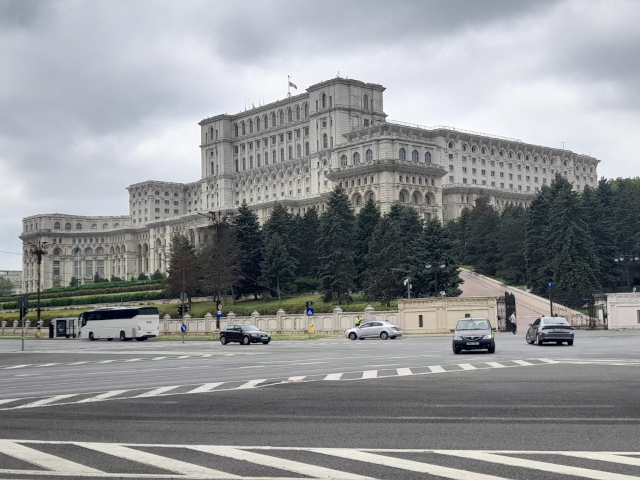
Parliament Palace, Bucharest
Slightly farther north is the University Plaza with its metro station and a small nearby park with an interesting "Broken Violin" sculpture. This is a theatre district with the huge but characterless "National Theatre" across the plaza, fronted by a large and impressive sculpture of theatrical performers.
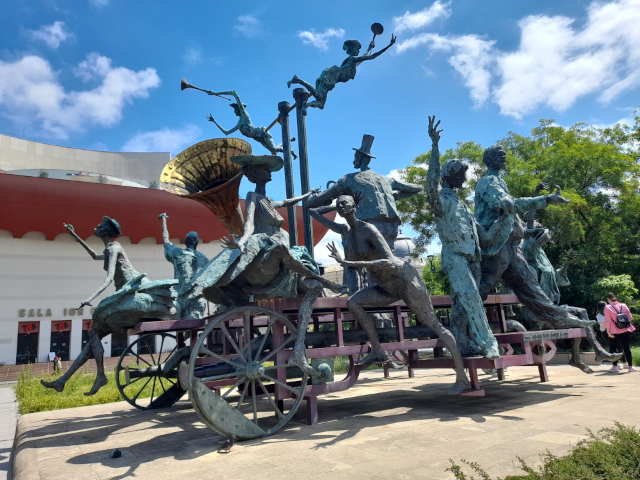
Theatre Performers Sculpture, National Theatre, Bucharest
From the theatre district it was only a short stroll past the Faculty of Architecture and the Carrefour store (where I later got some groceries) to home around early-mid afternoon. Rather a productive outing I thought. Dinner and drinks later were at a nearby Mexican restaurant, good.
On 10 May, as scheduled, we were back in the Gara de Nord for our 15:07 train to Budapest and Bratislava. Having a 2-tier 4-berth cabin, we enjoyed the luxury of being alone for most of the trip to Budapest. Scenery was pretty normal: farmland, villages and bush. It was a bit hot for me in a top bunk, but slept OK. Maggie was particularly thankful to be done with buses and able to enjoy the relative luxury and comfort of train travel.
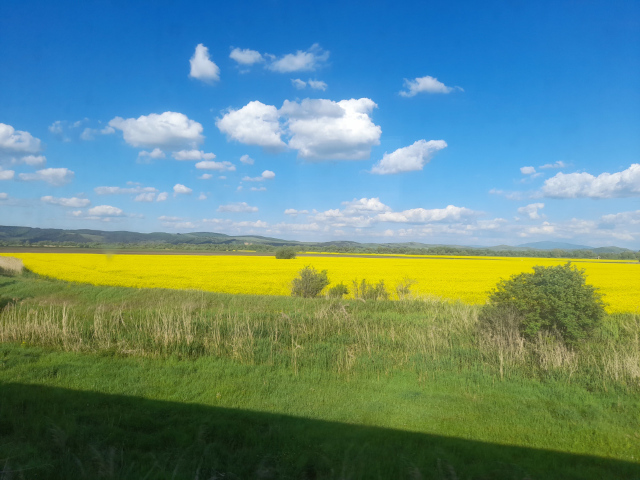
Canola in Rural Scenery, Romania
I found Romania, at least Bucharest, to be a good destination, lots to see and amiable enough to navigate, although I think Maggie was less impressed with the amount of walking required.
Slovakia
Into Budapest-Keleti on time at 05:00 (06:00 Romania time). From there we almost immediately set out on the over-2-km walk to Budapest Nyugati station, easy enough and arriving in plenty of time for our connection with the 07:30 to Bratislava.
Our train came directly into the Bratislava Hlavna station at 09:55, a real bonus, as our accomm is right nearby, only a few minutes walk. But of course we couldn't go there yet as check-in is 14:00. One unappreciated advantage of train travel is that they are generally on time, unlike buses which you never know when they'll get there.
First order in the train station is to try to arrange transport to Warsaw for 14 May. We went straight to a ticket window, asked about the train, and had a big scare that the train was booked out. It made me quite distressed; how would we get to Warsaw? Change days, take a bus or what? She said to go somewhere else in the station to an info counter or something, which we looked for and found. The woman there miraculously found reservations for us, and sold us tickets for 1st class (Maggie's preference) seats, leaving Hlavna 10:55 and arriving Warsaw Centralna 19:16. I still can't understand why the normal counter said full, and the other lady then found tickets for us. I quickly emailed, then called Jacek, to tell him when we're getting to Warsaw, so he's now OK with it.
With hours still before check-in, we found a coffee shop with wi-fi, and had coffee/cake and did emails and news etc. Later we could go to a nearby hostel and store our gear and sit until our 2 pm check-in at the guest house. It was a large place, about 3 rooms, well furnished, and relatively luxurious compared to some of our previous places. For the rest of the day we rested, grocery shopped and had a nice Vietnamese restaurant meal.
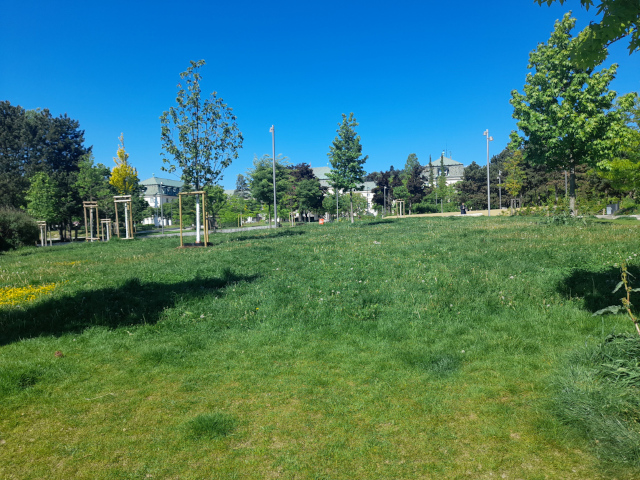
Weeds in Park, Bratislava
We'd have two full days in Bratislava, before moving on to Poland. On the first day we set out on an informal walking tour of Bratislava, trying to see at least some of the major sites in the Old Town and surrounds. Starting south from our place, we first went through a couple of parks. The Namiste Slobody has a radial pattern with a large fountain in the middle, though of course nowhere near the scale of the one(s) in Bucharest Union Boulevard. Again the parks here are not mown, with tall weeds growing where sittable lawn should be.
Grazolkovicov Palace must have been a functioning government place or something, as it had two unmoving ramrod guards out front. Behind was a Mary Theresa statue, curiously on a horse, and a head streaked with pigeon shit.
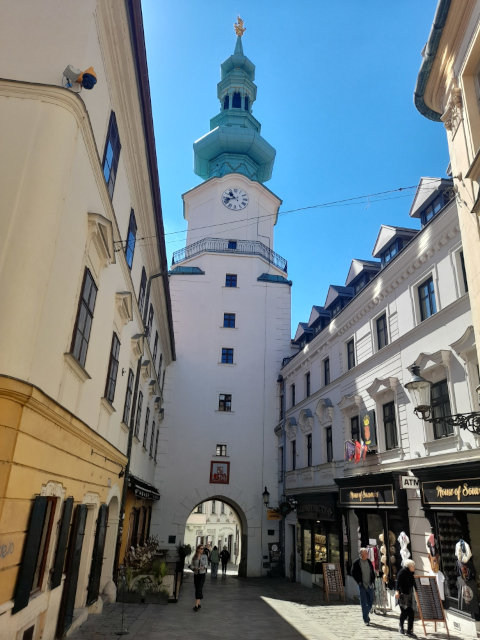
Michaels gate, Bratislava Old Town
Entering the historic Old Town, we passed through Michaels Gate with a large clock tower, and on to the attractive Hvalne Namestie square, flanked by The Starej Radnice building with a charming arch passageway. The long Hviezdoslavovo Namestie Square (well, rectangle) has the old but pretty Slovenske Narodne Divadlo theatre building at one end. The newer Arts Centre is nearer the river, and much bigger and more modern, but inevitably less attractive.
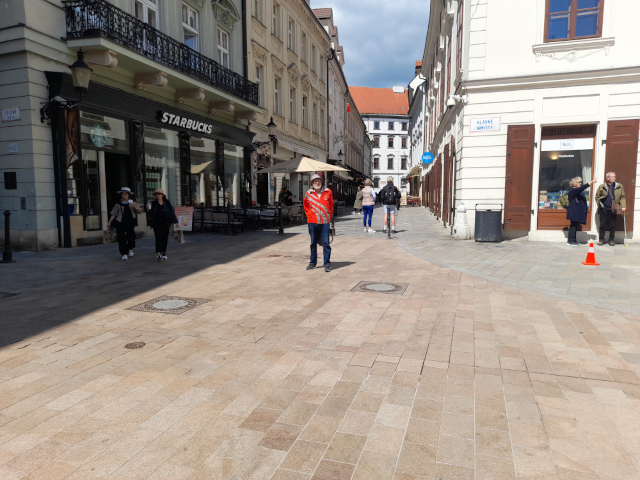
Hvalne Namestie Square, Bratislava
On to the grey-green (not blue) Danube River, we came across a plague monument (there seem to be a few of these around in different cities) and to the bridge across the river with its weirdly imposing "UFO" tower and restaurant.
I passed St Martins Cathedral with an impressively towering spire, but it's grand size didn't quite compensate for its rather plain exterior and interior. There was a mass on, so I didn't loiter. It was a somewhat heavy climb up to Bratislava Castle, with many steps and steep slopes, but Maggie handled it wonderfully. The castle, on a hilltop, had a nice ornately manicured garden and a large but empty interior courtyard, but not a lot else to recommend it. Views from the castle were a mixed bag, no clear view of the old town.
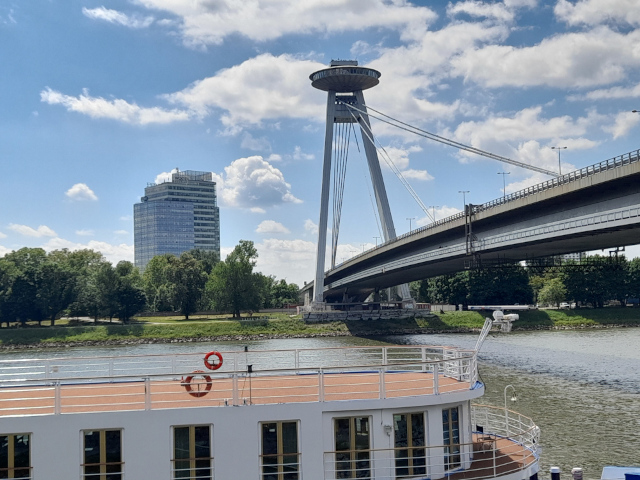
SNP Bridge and UFO, Bratislava
Back down the hill, through the tourist-infrastructure-clogged town centre, back past Michaels Gate and the Grazolkovicov Palace, we made our way slowly home by mid-afternoon. On our second day we'd already seen most of the Bratislava sites that we wanted to see. What remained was a promenade park next to the Danube, and the nearby large Eurovea shopping centre next to the new entertainment theatre. We left in the late morning to walk to the river, passing the Namiste Slobody park with it's fountain, and found nearby the radio station with it's huge odd-shaped upside-down pyramid structure.
Closer to the river we found the Elizabeth Church, distinctive for its blue-coloured exterior and interior.
The riverfront promenade was pretty enough, and the huge shopping centre was modern and accommodating. What made it distinctive was the proximity to the theatre and arts centre, which led to a profusion of bronze sculptures of artists and performers in and around the shopping mall. We spent some time exploring around the promenade, mall and theatre, before stopping for coffee and cakes and strolling the 2.8 km walk back home in the afternoon.
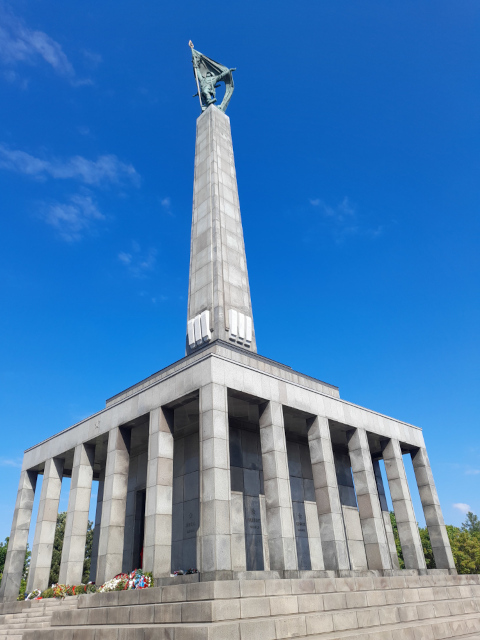
Slavin War Memorial and Cemetery
Sometime in Bratislava, I found the time to walk up the nearby Slavin Hill, a park dominated by a heavy and imposing Soviet/Russian war memorial and cemetery. Not for milquetoasts or bleeding heart liberals.
Poland
At our scheduled time of 10:58 on 14 May, we were at Bratislava Hvalna and on board for Warsaw. It was a very pleasant trip, comfortable first class, mostly alone in the cabin, enjoying bucolic forest, farm, village and town scenery, and chilling out with coffee and a meal in a real dining car. Our route took us out of Slovakia, through eastern Czech Republic, and into Poland. Being I think in the Shenzen countries, we were not bothered by passport check stops.
We came into Warsaw Centralna on time at 19:16. Right out of the carriage, we found our friend Jacek; great to see him. He took us out of the station into pouring rain. It took a couple of trips with a single umbrella to get us to his car, from which we drove home to his place.
The plan for our time in Poland was to be in Warsaw for a day or so. Then Jacek and Eva would take us up to Gdansk for few days. Then back to Warsaw briefly, and out to Mazurien Lakes for a few more days. Finally we'd be briefly back in Warsaw before flying out to Canada. Nice to be here; look forward to a pleasant relaxing time.
It seemed to be threatening rain off-and-on for the next few days. Also, it had been unseasonally warm in April, but now was to be unseasonally cool for the next while, both here in Warsaw and in Gdansk. On the morning of our day in Warsaw, it was fine at the time, but to rain a bit later. We first decided to do a walk around the neighbourhood for an hour or two before the rain came. We went a km or two through streets and neighbourhoods to the medium-sized Szczesliwicki Park, with its forest, walking paths, lake and toboggan hill. We noticed again that much of the open area was unmown tall grass and weeds, as in other places we'd been. It was a pleasant walk around the lake before we came back home in time to just miss rain.
Jacek and Eva drove us the 4+ hours up to Gdansk, let us stay in her apartment there, spent a couple of days with us, and gave us a few more days in and around this northern city. Gdansk was and still is a major port city, and formerly a shipbuilding hub. Now it is a major tourist destination, a beautiful place with much history and cultural heritage. It was the core of the Solidarity movement in the 1980's, and they're not shy of showing it.
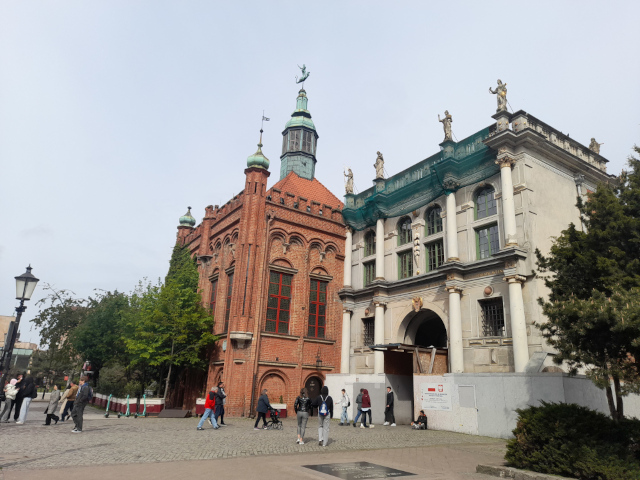
Long Walk, Old Town, Gdansk
We moved into Eva's beautifully spacious and furnished unit, and got ourselves organised. Then we went out to a nearby Polish bistro-type restaurant for a wholesome late-lunch of zurek soup and slightly stodgy but good meals of schnitzel, meatballs etc.
With the rain in abeyance for the moment, though it was a chilly single-digit temperature, we decided to start exploring the Gdansk old town. Our flat was situated a couple of bridges away from the old town, which was a charming enough walk on its own; many inviting shops, bars and restaurants. We crossed the Zeilony (green) Bridge, and entered the Brama Zeilona gate, which took us directly into the Long Market and Long Lane, the primary tourist boulevard stretching right across the town to the Golden Gate at the other end. Along the Long Lane were many historic and picturesque sites, including the Neptune Fountain (Neptune is the icon of Gdansk), and the Old Town Hall (now one of many museums). A near-infinite number of bars, cafes and restaurants lined the sides of the plaza/boulevard. In general, we found it a delight to walk in Gdansk, so much charm and so much to see. You could walk repeatedly and see new things every time.
Back along a smaller street and diverting into the large and impressive Maryi Panni Cathedral, we entered what could be called "Amber Street" (amber is a major product of Gdansk). Jewellery stores and stalls everywhere displayed the semi-precious stone.
One wet-day activity was the Museum of the Second World War. We spent over 2 hours in the large modern cubist building which housed the museum. The museum had a lot to see, very informative, but it was mostly photos, videos and text, with very little material or equipment displays. It was heavy on the propaganda as well, dead against all things German, Japanese and Soviet, with Poles as perpetual victims, and no balance or nuance. There was so much to see that near the end we were rushing through to get out of here.
Another day was a tram trip to the "Northern Beaches" with Jacek and Ewa, Maggie and myself. In the morning we took the tram (happened to be free that day) from near our place straight out past the main (Glowny) train station and to Jelitkowo beach town, about 12 km away. It was a sunny but cool day, good to get out but not for swimming.
Jelitkowo is a fairly typical beach place, with a wide sand beach, seaweed on the sand, bars/restaurants along the beach, sailboats out on the water and ships at anchor even farther, and lots of beach-goers. We walked along the beach and pathways to the next town Sopot, about 3 km north. It was a pleasant stroll, getting to Sopot around noon. We looked around Sopot town, quite built up and reasonably attractive, before getting a train back to Gdansk and our apartment.
J&E returned to Warsaw later in the afternoon. They were great with all the things they did looking after us.
One day Maggie would spend some time in a shopping mall, and I would go to the Solidarnosci (Solidarity) Museum. Outside the museum is an outdoor plaza with a monument to the movement, in the shape of three enormous concrete crosses, presumably commemorating the martyrs etc. The museum itself is also enormous, a cubist edifice constructed of rust-coloured steel reminiscent of the steel used to build ships in the nearby factories. Inside was pretty much as expected, with text, photo and video, and an audio guide, of the story/events of the strikes and repression etc in the 1970's and 1980's. I spent maybe a couple of hours there, shepherded by the audio guide.
On another day out, we took a train to Malbork Castle, south of Gdansk. We took a tram into the main (Glowny) station, and got tickets to Malbork for the maybe 1/2 hour ride there. From the station it was a 1.2km walk to the castle situated on the edge of a river.
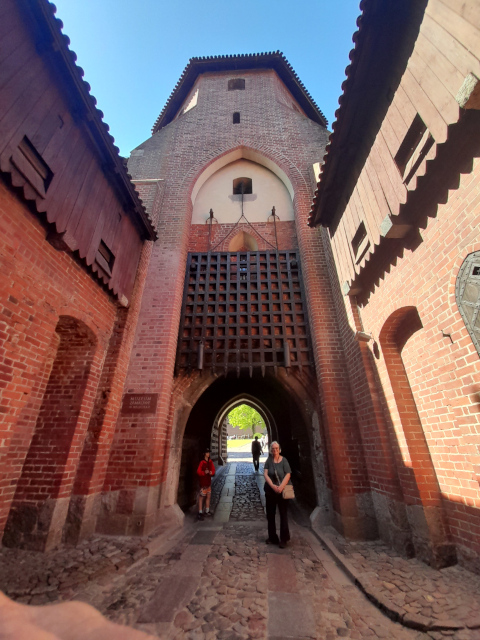
Malbork Castle
Malbork Castle is the world's largest brick castle. It consists of a high castle and a low one, all within the same compound. The audio guide ordered us through on a set route, giving commentary and information all the way, and discouraging any diversions. Even being the "minimal" itinerary, it was quite an extensive tour, taking in many corridors, gateways, arches, courtyards, chapels, rooms and staircases, with many exhibits of everything from kitchen equipment to military armaments. It must have gone for over two hours and really tired us out. I guess it was worth it, but I think Maggie again OD'ed on museum exhibits.
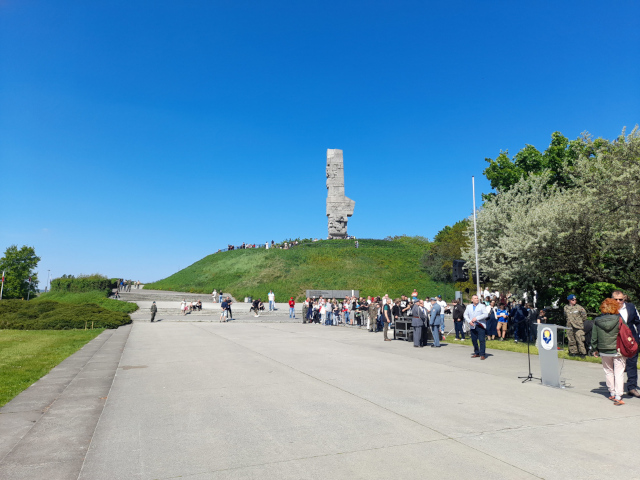
War Monument and Military Ceremony, Westerplatte
Another activity was a bus ride out to Westerplatte, with it's beach, spit of land, lighthouse and site of much WWII action. I looked forward to exploring the park and beach and lighthouse. Weather was unusually warm, sunny and pleasant, requiring minimal raiment. However I found Westerplatte to be a disappointment, not all I'd expected. The park we stopped in wasn't all that large or exciting. The beach, spit and lighthouse, about 1.5 km away, were all a military security area and off limits. So we couldn't really walk very far, and there wasn't much to see, except some information signs recounting the wartime history and people, the busy docklands and passing ships. There was a large war monument which was interesting. At the time there was some sort of military ceremony being set up and taking place, many personnel in uniform, speeches/commands, patriotic music, uniforms and medals, marching and so on. We looked at the memorial and the ceremony, and walked as far as we could to the end of the park, turned around, and back to the bus stop. It was very crowded coming back as the military ceremony crowd was also returning.
On yet another day, we walked to the Brigid Church to see the famous Amber Altar. Getting there, we could view the altar and other exhibits/artefacts in the church. The church and decor are relatively plain compared to most, except for the very large and ornate altar, replete with amber and gold-coloured relief objects and other decorations, all too complex to fully appreciate from a distance. Elsewhere in the church is a crypt with hundreds of skulls, presumably from deceased nuns that had been entombed there through the ages. Also much in evidence are extensive sculptures and displays and artefacts from the WWII and the Solidarity period, all with a strong revolutionary/militaristic aspect. I found it to be somewhat out of place and offensive, so much war stuff in a Christian place of worship. For example, next to a sculpture of the body of Christ was a dead soldier, and part of another sculpture had the Virgin Mary with rifle bayonets. Not in good taste I thought.
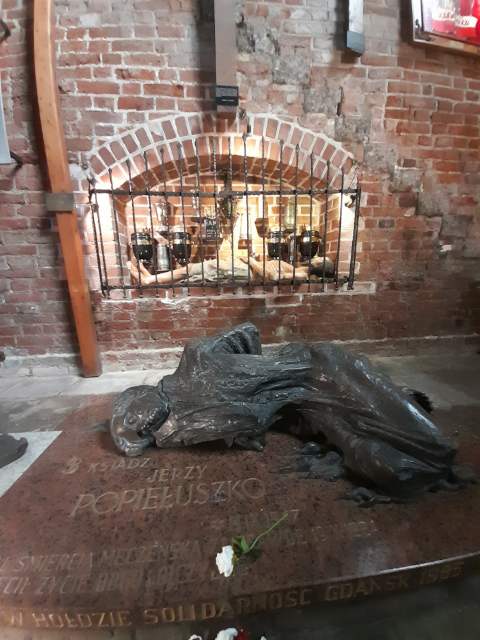
Christ and Dead Soldier, Brigid Church
On 23 May we took a train from Gdansk back to Warsaw, a comfortable, if slightly crowded, ride. We'd be only one night at Jacek's place before he would drive us up to a lodge in the Mazurien Lakes district. This would be our "bush/wilderness" experience on Poland.
Mazurien Lakes is about a 3+ hour drive through pleasant forest, farmland and towns. We arrived in the early afternoon at the quiet lakeside hamlet Kamien, on the west side of a lake channel. We met Kristoff the property owner and checked in to a nice room with bath, balcony etc. in a large guest house. Weather was slightly cool but sunny and pleasant.
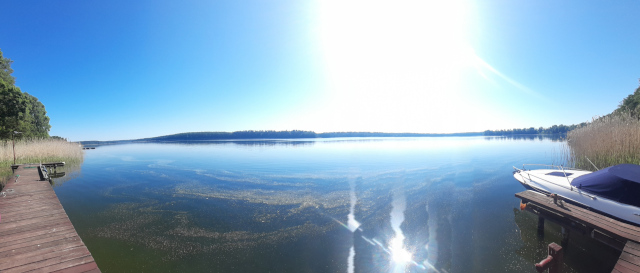
Lake View from Guest House, Kamien
After settling in, Jacek took us out quite a few km to a late lunch in the village Glodowo in the south of the lake. We passed through the villages Wygryny, where there's a couple of grocery stores, and Ruciane-Nida, with the railway and bus stations (we plan to come back this way, as Jacek is only staying with us a couple of days). The Restaurant Rybna specialised in local fish and dished up delectable pike-fillet dishes, very nice.
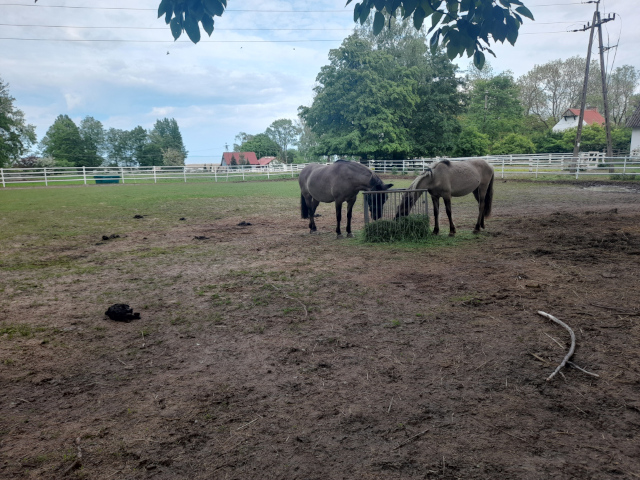
Konik Horses, Mazurien Lakes
On the way back home, we diverted to a "wildlife park", a fenced off area where there are protected native Polish "konik polski" horses. We didn't see any of the wild ones, but did get into a farm setting where there were several of the tame full-sized grey-coloured horses and foals in enclosed pastures.
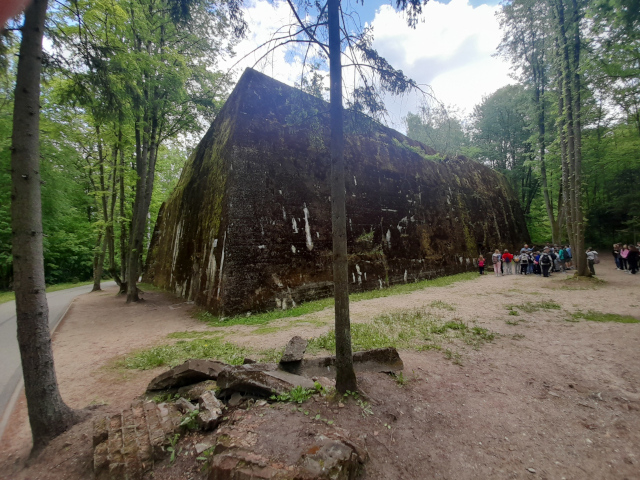
One of Many Bunkers, Wolfs Lair
Jacek would only be with us for a couple of days before leaving us and heading back to Warsaw. One of the main sites he wanted to show us was the Wolfsschanze, Hitler's "Wolf's Lair", an hour or more drive north of Kamien. The Wolf's Lair complex is a network of massive ruined concrete bunkers and brick buildings, much more vast and extensive than expected. There are well over a dozen structures over a large area. It took and hour or two to go through it all. Maggie was pleased that it was mainly the ruined buildings, with relatively little museum-type exhibits to take up time. It was all rather imposing and morbid, but well worth while.
On the way back to Kamien, we diverted west to the town Swieta Lipka. There is a large church, Maryi Panni, with a large and elegant pipe organ which I understand is a copy of the one in Oliwa, Gdansk called the Koroni Polski. Apparently this church was founded when a cowherd saw a vision of a tree with the Madonna in it, and was instructed to build the church there. Thus the church contains a representation of the tree and Madonna in the church. We stayed to attend a pleasant afternoon organ recital. There are several moving parts and statues on the organ, giving it a visual, as well as audio, appeal.
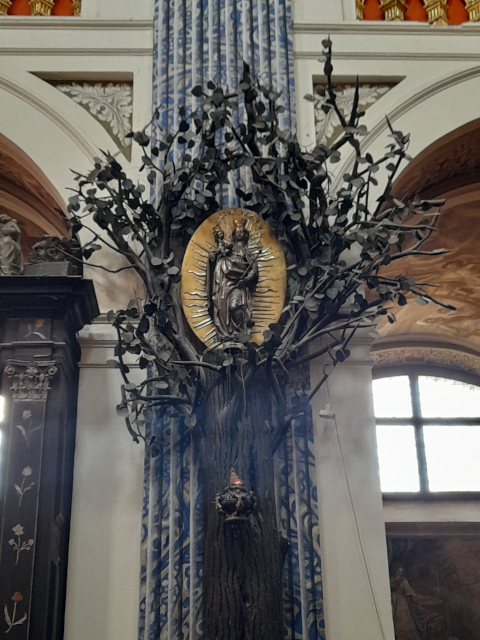
Madonna Tree in Maryi Panni Church
Next day Jacek is to return to Warsaw, but not before taking us around to a couple of places with culturally significant religious institutions. First was the nearby township Wojnowo. The community extends for some distance along a road, and was currently hosting a photographic exhibition of Polish photographers. All along the road were rows of artistic photos lined up along fences and walls, a section for each photographer. We spent some time stopping here and there to admire the captivating exhibits.
Also in Wojowno was the Monastery of Old Believers (Staroobrzedowcow), an old branch of the Orthodox church that was persecuted in Tsarist Russia and later by the Bolsheviks, and fled to this district. The church/hermitage contains antique furnishings and 19th century period artefacts, and a very interesting small orthodox cemetery out the back.
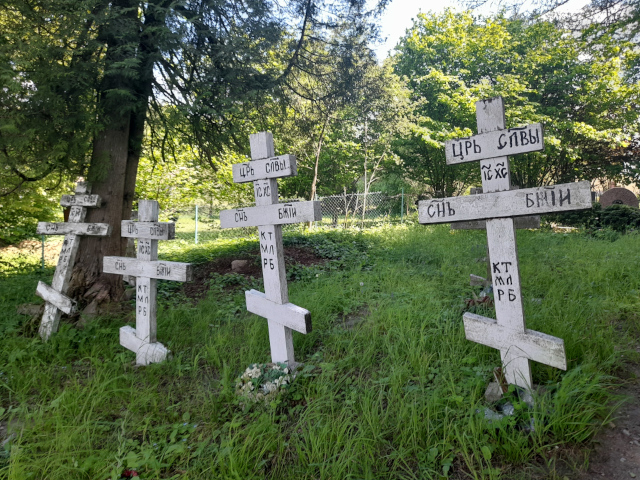
Old Orthodox Church Cemetery
Farther on was a more mainstream Orthodox church and Jesuit monastery, with a quaint architecture and blue-white colour scheme, unfortunately closed to entry at the time.
Interesting that for a while we had no internet. Apparently the army or NATO or whatever were doing exercises which including jamming communications or something, disrupting civilian internet. The price we pay for security!
We would be now on our own for a couple of days before returning to Warsaw. One activity we were looking forward to was a bike ride. Kristoff set up a couple of bikes for us and we got away maybe around 11 am. It was near-perfect conditions for cycling, sunny and not too hot, easy bike routes beside or on the roads, and not a lot of traffic. We rode out via the dirt road to the main road, a few km into the village Wygryny, and a few more km to Ruciane-Nida. In RN, we found one of very few restaurants open, where Maggie could get a coffee and cake and sit a while. I left my bike there and did a bushwalk for an hour or so along a lakeside and then through forest back into town. Nothing spectacular, but a good introduction to the topography and flora of the area. Back at the restaurant I picked up Maggie and we slowly rode back to Kamien by about 14:00. There were a few hills and slopes, so Maggie had had enough by then.
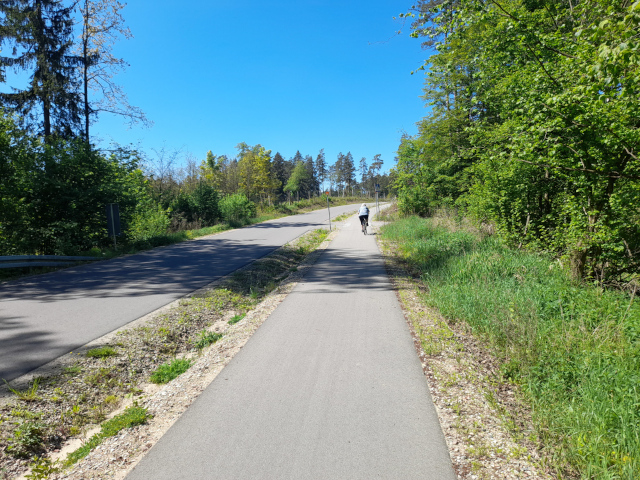
Cycling, Mazurien Lakes
Another day I took a walk through nearby bush for a couple of hours. The forest in the area is consisted of a mixture of deciduous and conifer trees including the tall straight pine-type trees that dominate, and mainly sparse undergrowth. Lots of blueberry patches (pre-season) and strawberries, nettles and other flora. It seems to be regularly logged, with many fenced off square patches of re-planted trees just coming up. The whole forest is interspersed with a complex grid of interconnecting fire and logging trails. You can pick a trail, walk to an intersection, pick another trail, walk to the next intersection, ad-infinitum. I walked several trails and trail segments, and eventually made my way back home.
On 29 May, we checked out today to go to Ruciane-Nida for a 3:15 bus back to Warsaw. Christoff kindly allowed us to stay until at 14:45 he drove us to the bus in Ruciane, helped us purchase bus tickets, and saw us onto the bus. Great guy!
The bus ride took to Warsaw via Pisz and Lomza, mostly through bucolic agricultural country. Back at Warsaw Centralna around 19:45, Jacek was there with his car to meet us. While Jacek and Eva were at work, Maggie and I would do a walk around the nearby Szczesliwicki Park. The park is quite pleasant and picturesque with all fauna in green spring foliage and fragrant flowers out. From there we strolled over to the Blue City shopping mall, and explored around the mall a while.
On the Saturday and Sunday, Jacek and Eva are off work, and we could do things together. There's a park in the south-east of Warsaw about 10 km away, with a large ornate palace called Wilanowa, sort of a mini-Versailles. It was built for King John III Sobieski in the late 17th century, was owned by a number of families since then, and has largely survived two world wars and other destructive events. It is one of the most important Polish monuments and examples of Baroque architecture. We were able to join an English language group tour of the palace. The palace is quite large and grand, with a main end section and two long sides. Surrounding is a large well-manicured park in which one can wander extensively. The tour took about 3/4 hour, and was a good introduction to the many rooms, frescoes, paintings and furnishings. Much of the content was not original, the palace having been looted by Germans and Russians in WWII.
After the palace we went into town for a fancy dinner at the Restauracja U Kucharzy w Arsenale for. We had been here before in 2016, and had then found it to be an elegant dining experience. And so it was again.
After dinner, we walked for a while around the city centre and old town, to revive fading memories of when we were here in 2016. At that time the weather was relatively miserable, which is maybe why it hadn't stuck much in my mind. Anyway, seeing the old city walls and the re-built plaza district etc brought a lot of it back to me.
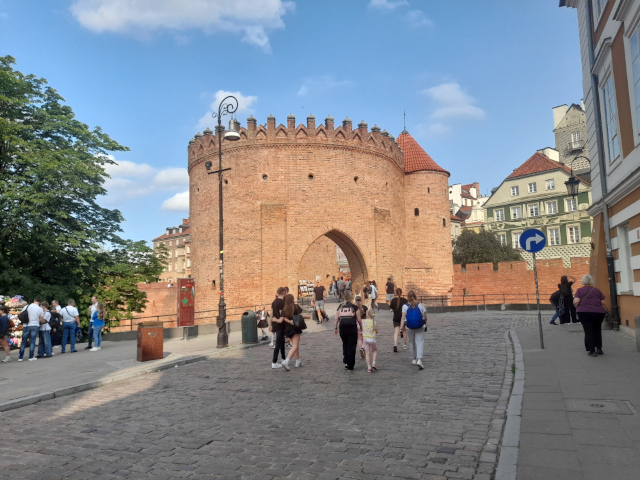
Old Town Walls and Gate, Warsaw
On Sunday a concert was being performed at noon in the Krolewski Park in the SE centre of the city. Jacek collected Ewa and us and the four of us took public transport and walked to the park. Weather was sunny and much warmer than it had been, almost too hot. The concert featured Chopin solo pieces - nocturnes, mazurkas etc - performed by young (9 to 13-year-olds) talented kids, went for maybe an hour or so, and was well done, professional and quite enjoyable.
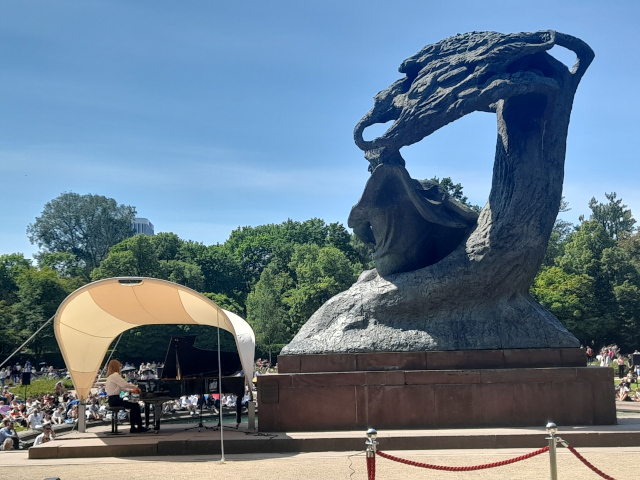
Chopin Sculpture with "Hand"
Towering over the stage venue was a large Chopin statue, with an even larger effigy towering above him. The rather scary-looking effigy looked like a grim reaper figure, but was said to represent an enormous set of hands playing an instrument. The park itself was large and beautiful, with many paths, forests, lakes, ponds, a smallish island palace, and hordes of people.
That brings us up to 2 June, the day we leave Poland and fly back to Canada.
Jacek drove us to the nearby international airport, we were on our 14:05 flight to Toronto, and a connection to Winnipeg, arriving at 23:20 to be picked up by Craig and Graeme. It was a fairly normal and routine flight, although we had a bit of a scare when LOT Airlines could not confirm our leg from Toronto to Winnipeg, the flight having been "cancelled". Some last-minute fiddling in Toronto finally got us onto an alternative flight, so all was good.
This was the second time I'd been to Poland. I love it there, especially as we have friends who can smooth the journey and look after all our needs.
Now I have a couple of months in Manitoba before heading back to Ausrtalia. It's expected to be a busy time.
